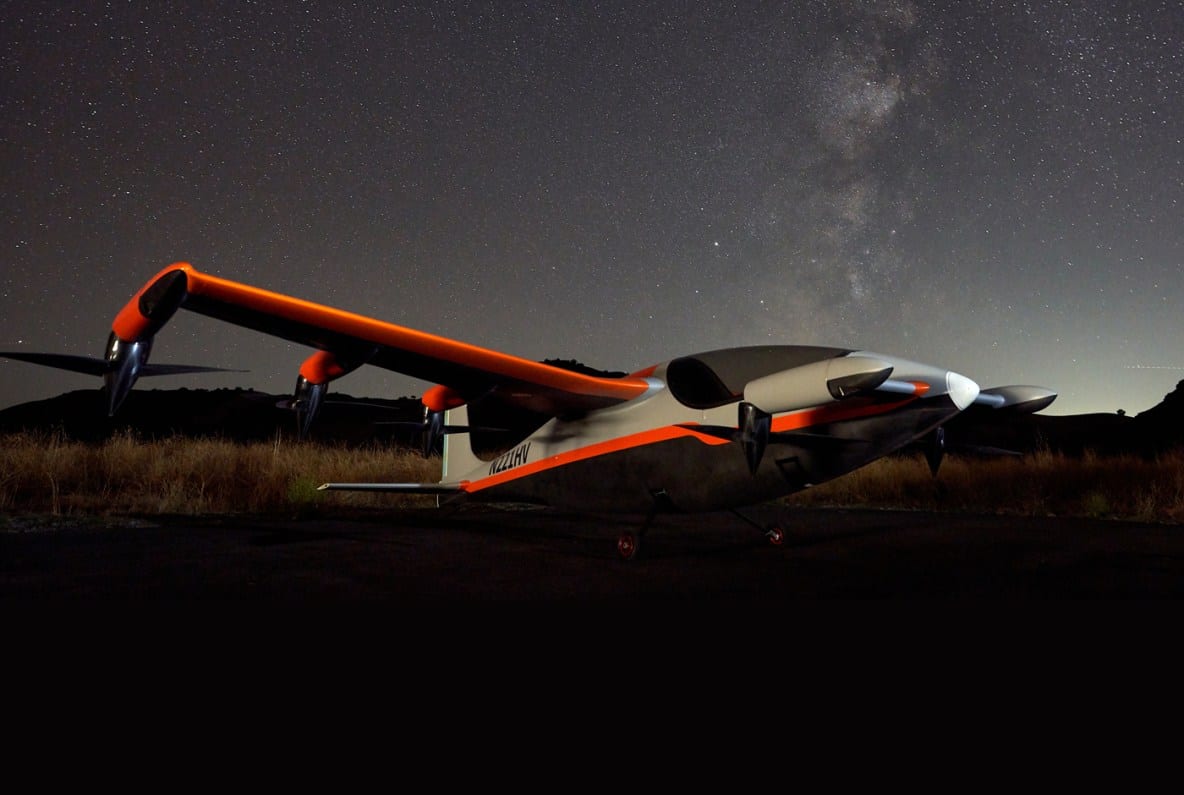
The Kitty hawk HVSD eVTOL aircraft, revealed after two years of stealth development. (Kitty Hawk)
The secretive electric aircraft company Kitty Hawk, backed by Google co-founder Larry Page, revealed its third electric vertical takeoff and landing (eVTOL) design: a small, quiet aircraft with eight tilting propellers called ‘Heaviside,’ named after engineer and physicist Oliver Heaviside (1850-1925).
Heaviside, or HVSD as the company prefers to call it, fits only one person and is one-third the weight of a Cessna. The aircraft’s eight propellers along with their electric motors, six on the main forward-swept wing and two on its forewings, tilt downwards for VTOL purposes and forward for vertical flight. It can travel from San Jose to San Francisco — a distance of 55 miles — in 15 minutes, according to TechCrunch’s Kirsten Korosec, which entails a cruise speed over 200 mph.
The most striking feature of HVSD, however, is what’s missing: the noise. Kitty Hawk claims the aircraft emits 1/100th the noise of a traditional helicopter. According to Korosec, the company demonstrated a helicopter registering at 85 decibels roughly 600 feet in the air; HVSD briefly emitted 80 decibels as it took off, but was barely noticeable at 600 feet of altitude with a reading below 40 decibels.
“The calculus here is that this has to be socially acceptable for people, said Sebastian Thrun, CEO of Kitty Hawk, formerly co-founder of Alphabet’s moonshot organization, X. “There’s a reason why helicopters are not: they’re for rich people and they’re noisy.” Thrun’s company originally developed its Flyer vehicle concept, followed by Cora, which was tested extensively without a pilot in California and New Zealand.
Kitty Hawk hopes HVSD will be used for personal air travel and air taxi service. They have been developing and testing the aircraft, in secret for the past two years, both with and without a pilot, but its interface is designed to be used by those without a pilot license.
Speaking at the Economic Club of New York earlier this week, Boeing CEO Dennis Muilenburg expressed confidence autonomous vehicles and urban “flying taxis” will be commercially deployed in the near future.
“I would not be surprised to see revenue-bearing operations in those kinds of autonomous vehicles within five years,” Muilenburg said.
Boeing’s HorizonX Ventures and NeXT divisions are working on a number of aircraft designs and technologies in this area, including through the purchase of Aurora Flight Sciences, an Uber Elevate vehicle partner, and the company’s Cargo Air Vehicle design.
“I think you’ll see [autonomous vehicle application] first with freight delivery,” Muilenburg said. “You’ve seen many players who now are looking at drone delivery of packages. That’s an initial step. You’ll see that grow with time. We could see things like freight delivery in autonomous vehicles could happen in the near term.”
 | Want more eVTOL and air taxi news? Sign up for our brand new e-letter, “The Skyport,” where every other week you’ll find the most important analysis and insider scoops from the urban air mobility world. |
HVSD marks tremendous progress on the acoustic issues surrounding eVTOL aircraft and urban air mobility, which will be key to the public acceptance necessary to allow these future aircraft to take flight en mass and contribute to decongesting traffic-choked roads, as evangelizers hope it will.
Kitty Hawk has hired former FAA administrator Mike Huerta, who stepped down in 2018, as an advisor as it pursues FAA certification for the aircraft.